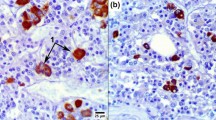Abstract
Female laboratory macaques were studied under a variety of treatment protocols to determine if immunoreactive luteinizing hormone/gonadal chorionic gonadotropin (LH/CG) receptors were present in the adrenal cortex. All adrenal tissues revealed an absence of immunoreactivity in the in the medulla while staining was present in all three outer zones of the cortex. Increased staining was observed in the zonae reticularis with least staining in the zonae glomerulosa. Moderate and variable staining was found in the zonae fasciculata. These results demonstrate that LH/CG receptors in the adrenal cortex may be more common in higher primates than previously recognized and help explain some aspects of the endocrine changes observed in mid-aged women during the menopausal transition when circulating LH concentrations are rising.
Similar content being viewed by others
References
Lasley BL, Santoro N, Randolph J, Gold EB, Crawford S, Weiss G, McConnell DS, Sowers MF 2002 The relationship of circulating dehydroepiandrosterone, testosterone, and estradiol to stages of the menopausal transition and ethnicity. J Clin Endocrinol Metab 87:3760–3767
Crawford S, Santoro N, Laughlin GA, et al. Circulating dehydroepiandrosterone sulfate concentrations during the menopausal transition. J Clin Endocrinol Metab. 2009; 94(8):2945–2951.
Lasley BL, Crawford SL, Laughlin GA, et al. Circulating dehydroepiandrosterone sulfate levels in women who underwent bilateral salpingo-oophorectomy during the menopausal transition. Menopause. 2011; 18(5):494–498.
Lasley BL, Stanczyk FX, Gee NA, et al. Androstenediol complements estradiol during the menopausal transition. Menopause. 2012; 19(6):650–657.
Lehmann WD, Lauritzen C. HCG + ACTH stimulation of in vitro dehydroepiandrosterone production in human fetal adrenals from precursor cholesterol and delta5-pregnenolone. J Perinat Med. 1975; 3(4):231–236.
Seron-Ferre M, Lawrence C, Jaffe R. Role of hCG in regulation of the fetal zone of the human fetal adrenal gland. J Clin Endocrinol Metab. 1978; 46(5):834–837.
Pabon J, Li X, Lei Z, Sanfilippo J, Yussman M, Rao C. Novel presence of luteinizing hormone/chorionic gonadotropin receptors in human adrenal glands. J Clin Endocrinol Metab. 1996; 81(6):2397–2400.
Rao CV, Zhou XL, Lei ZM. Functional luteinizing hormone/chorionic gonadotropin receptors in human adrenal cortical H295 R cells. Biol Reprod. 2004; 71(2):579–587.
Moran F, Chen J, Lohstroh PN, Gee NA, Lasley BL. Dehydroe-piandro- sterone sulfate (DHEAS) levels reflect endogenous LH production and response to human chorionic gonadotropin (hCG) challenge in the older female macaque (Macaca fascicularis). Menopause. 2012; 20(3):329–335.
Nishii M, Masahi N, Sekine Y, et al. Luteinizing hormone-releasing hormone antagonist reduces serum adrenal androgen levels in prostate cancer patients:Implications for the effect of LH on the adrenal glands. J Androl. 2012; 33(6):1233–1238.
Mikola M, Kero J, Nilson JH, Poutanen M, Huhtaniemi L. High levels of luteinizing hormone analog stimulate gonadal and adrenal tumorigenesis in mice transgeneic for mouse inhibin-alpha-subunit promotor/simian virus 40 T-antigen fusion gene. Oncogene. 2003; 22(21):3269–3278.
Conley AJ, Stanczyk FX, Borowicz P, Benirschke K, Gee NA, Lasley BL. Modulation of higher primate adrenal androgen secretion with estradiol or estradiol and progesterone intervention. Menopause. 2012; 20(3):222–228.
Pabon JE, Li X, Lei ZM, Sanfilippo JS, Yussman MA, Rao CV. Novel presence of luteinizing hormone/chorionic gonadotropin receptors in human adrenal glands. J Clin Endocrinol Metab. 1996; 81(6):2397–2400.
Shideler SE, Gee NA, Chen J, Lasley BL. Estrogen and progesterone metabolites and follicle-stimulating hormone in the aged macaque female. Biol Reprod. 2001; 65(6):1718–1725.
McConnell DS, Santoro N, Randolf JR, Stanczyk FZ, Lasley BL. Menopausal transition stage-specific changes in circulating adrenal androgens. Menopause. 2012; 19(6):650–657.
Carlson HE. Human adrenal cortex hyperfunction due to LH/ hCG. Mol Cell Endocrinol. 2007; 269(1–3):46–50.
Kamoun M, Mnif MF, Charfi N, et al. Adrenal diseases during pregnancy:pathophysiology, diagnosis and management strategies. Am J Med Sci. 2014; 347(1):64–73.
Rask E, Schvarcz E, Hellman P, Hennings J, Karlsson FA, Rao CV. Adrenocorticotropin-independent Cushing’s syndrome in pregnancy related to overexpression of adrenal luteinizing hormone/human chorionic gonadotropin receptors. J Endocrinol Invest. 2009; 32(4):313–316.
Saxena AR. Seely Luteinizing hormone correlates with adrenal function in postmenopausal women. Menopause. 2012; 19(11):1280–1283.
Cirillo M, Bilancio G, Marcarelli F. Ageing and changes in phosphate transport:clinical implications. J Nephrol. 2010; 23(Suppl 16):S152–S157.
Author information
Authors and Affiliations
Corresponding author
Rights and permissions
About this article
Cite this article
Lasley, B., Conley, A., Morrison, J. et al. Identification of Immunoreactive Luteinizing Hormone Receptors in the Adrenal Cortex of the Female Rhesus Macaque. Reprod. Sci. 23, 524–530 (2016). https://doi.org/10.1177/1933719115607991
Published:
Issue Date:
DOI: https://doi.org/10.1177/1933719115607991




